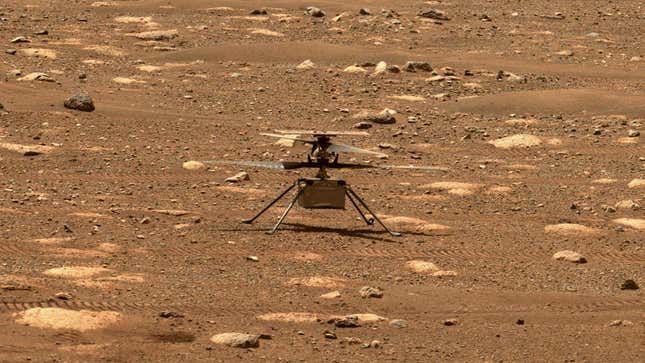
The Ingenuity helicopter will need to wait a couple of weeks for its next flight, as Mars is fully on the far side of the Sun from Earth, disrupting communications with spacecraft stationed there. But all solar conjunctions aside, the helicopter has another issue: It needs to adapt to a changing atmosphere.
The problem comes down to the fact that Ingenuity has been way too good at what NASA designed it for. The plan was for the helicopter to demonstrate the utility of controlled, powered flight on Mars, for the sake of future exploration of the planet and, perhaps someday, more regular travel on it.
Ingenuity was to demonstrate that in five flights; when the helicopter passed those tests, it was promoted to a Martian scout, flitting around the hazy tan skies to assist the Perseverance rover in its science mission. It has done that well, too.
But having endured all these challenges, the Ingenuity helicopter finds itself in the weird position of needing to learn how to fly differently to accommodate for Mars’ changing seasons; when the planet gets colder, the atmospheric pressure drops. But a flight test scheduled for September 18, to acclimate to the atmospheric changes, was cancelled automatically by Ingenuity after the helicopter detected some irregularities in its motors.
The anomaly is yet to be fully understood, but, according to a blog post by deputy operations lead Jaakko Karras, it occurred in two of the six motors that run the mechanism that manages the helicopter’s pitch. Those motors, called servos, go through regular, automated testing on Mars.

“The servo motors are much smaller than the motors that spin the rotors, but they do a tremendous amount of work and are critical to stable, controlled flight,” Karras wrote. “Because of their criticality, Ingenuity performs an automated check on the servos before every flight.”
So far, what NASA understands of the servo anomaly is that the motors were wobbling a bit; additional tests were run on September 21 and September 23 and nothing untoward happened, so perhaps it was a fluke.
“One theory for what’s happening is that moving parts in the servo gearboxes and swashplate linkages are beginning to show some wear now that Ingenuity has flown well over twice as many flights as originally planned (13 completed versus five planned),” Karras wrote. “Another theory is that the high-speed spin test left the upper rotor at a position that loads servos 1 and 2 in a unique, oscillation-inducing way that we haven’t encountered before.”
The issue doesn’t seem catastrophic, and with the additional tests showing things to be nominal, Ingenuity likely will be up in the air again soon. The solar conjunction lasts from October 2 to October 14. If the helicopter continues to impress as it has thus far, it will find flying in the winter Martian atmosphere no issue at all.
More: Listen to the Incredible Sound of NASA’s Ingenuity Helicopter Flying on Mars